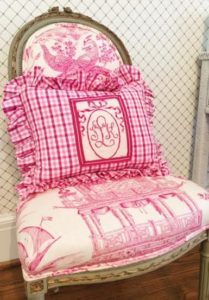
I got asked yesterday about where to find a particular finishing supply. This got me to thinking. We might be good seamstresses or do OK at finishing, but often our results don’t turn out as nicely as we would like. It’s not because we didn’t do a good job, but it’s because we can’t find the materials we need to make our finishing great.
I suspect that professional finishers are buying many of their supplies from wholesale sources, but that just means we need to be more creative. Today we’ll look at sources for the soft parts of needlepoint finishing. Tomorrow we’ll look at items made from wood and metal.
Fabrics
If you have ever tried finishing your own needlepoint, you know you need sturdy fabric to do so. It’s very easy to find velveteen, which works well. So do velour and uncut corduroy, both of which look like velveteen. Ultrasuede is also outstanding for needlepoint, but it can be hard to find. If you want Ultrasuede, do an Internet search for nearby and on-line sources.
For other fabrics look for decorator fabrics. Most of these are either drapery weight, which are usually heavier cottons, or upholstery weight, which are very heavy. Drapery weight is your best choice because it has a wider variety of styles and can be sewn with a regular sewing machine.
It’s easier to find these fabrics than you might think. Many fabric shops have cuts of decorator fabrics ready for you to buy. Others have a selection on bolts. Other shops have samples where you can order fabric. If a shop or interior designer has samples from time to time those samples will be discontinued. Look for these or ask about buying them.They are very cheap and are in excellent sizes for our needs.
Finally if you are lucky enough to know an upholsterer or live near a place that makes draperies, you might ask them about getting larger scraps and bolt ends. All of my finishing fabric was gotten this way.
Trims & Cording
One of the things that distinguishes professional finishing from our own efforts is the quality of the trim. Great trim is not cheap and you won’t find it in chain fabric stores. This leaves you with two options. You can make your own using tools such as Kreinik’s Custom Corder. This makes twisted cord, but it also can use many different weights of thread.
You can also make your own Pearl Cotton, combining different colors, strands, and weights to make the twisted cord you want. Linda Reinmiller has a one-page PDF tutorial.
But what if you want something beyond twisted cord? Then you’ll have to look around. Your best bets are stores that specialize in trims, such as M&J Trimming, a NYC store that has a huge selection of trims and an extensive site. Another store with a great selection of trims is Britex in San Francisco.
Trims are used extensively in theater productions for the costumes. Costume shops, theater companies, and drama departments in your area might be able to give you leads for where to find trims. They also might know sources for unusual fabrics. Don’t be alarmed if they say they rent costumes, many smaller companies do because costume-making is hard. Ask them the name of the shop. It may take some digging but these guys are amazing sources.
Pillow Forms
It’s so easy when making a pillow just to stuff it with fiberfill. It’s cheap and easy to find. Your pillows will look and wear better if instead you use a pillow form. These are sewn and stuffed pillows tat go inside your pillow.
The least expensive are made from thin sheets of fiberfill and are filled with more fiberfill. They only come in a few sizes. You can find these at most fabric stores.
A better choice are fabric pillow forms (like the pillow you sleep on). They come in dozens of sizes and in many types of fill. I get mine on Amazon.
When you buy a pillow form it should be 1″ bigger than your pillow. This gives you a nice fully-stuffed pillow.
Interfacing
If you make purses or ornaments you want them to be stiff. If it will be covered on both sides, you can use plastic canvas because it is both thin and flexible. The interfacing you find in fabric stores is rarely stiff enough.
The product you want is called Skirtex and is a stiffener. You would use it, for example, to make the skirts on chairs be stiff. For our purposes even a small amount will last quite awhile.
Skirtex is easy to use and is great for ornaments. You can find it at drapery and upholstery supply shops, but I have even seen it on Amazon.
About Janet M Perry
Janet Perry is the Internet's leading authority on needlepoint. She designs, teaches and writes, getting raves from her fans for her innovative techniques, extensive knowledge and generous teaching style. A leading writer of stitch guides, she blogs here and lives on an island in the northeast corner of the SF Bay with her family

I think there need to be more books on how to do finishing, especially on finishing 3-d forms; –stuff besides the normal pillows and pictures. I love doing needlepoint, but the finishing is so expensive, and good instructions are hard to find. Sometimes I just throw things in the drawer when I’m done. Years ago I tried to finish one figure in a little Nativity set, and it was a disaster; I was surprised the finisher was able to rescue it, but she did.
A very comprehensive book on finishing is Finishing 101 by Pat Mazu. Here’s the link to my review of it:
https://nuts-about-needlepoint.com/finishing-101-needlepoint-book-review/
You can purchase it through Stitches from the Heart in Indiana or your LNS.
Keep stitching,
Janet